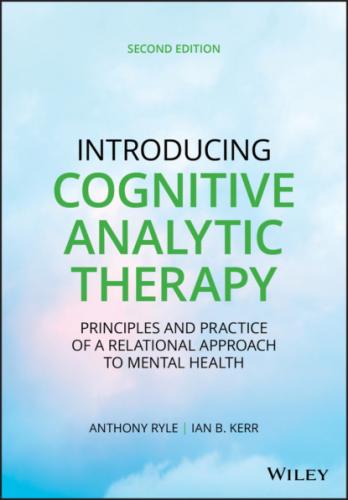Introducing Cognitive Analytic Therapy. Anthony Ryle
The right of Anthony Ryle and Ian B. Kerr to be identified as the author of the editorial material in this work has been asserted in accordance with law.
Registered Office John Wiley & Sons, Inc., 111 River Street, Hoboken, NJ 07030, USA John Wiley & Sons Ltd, The Atrium, Southern Gate, Chichester, West Sussex, PO19 8SQ, UK
Editorial Office 111 River Street, Hoboken, NJ 07030, USA
For details of our global editorial offices, customer services, and more information about Wiley products visit us at www.wiley.com.
Wiley also publishes its books in a variety of electronic formats and by print‐on‐demand. Some content that appears in standard print versions of this book may not be available in other formats.
Limit of Liability/Disclaimer of Warranty While the publisher and authors have used their best efforts in preparing this work, they make no representations or warranties with respect to the accuracy or completeness of the contents of this work and specifically disclaim all warranties, including without limitation any implied warranties of merchantability or fitness for a particular purpose. No warranty may be created or extended by sales representatives, written sales materials or promotional statements for this work. The fact that an organization, website, or product is referred to in this work as a citation and/or potential source of further information does not mean that the publisher and authors endorse the information or services the organization, website, or product may provide or recommendations it may make. This work is sold with the understanding that the publisher is not engaged in rendering professional services. The advice and strategies contained herein may not be suitable for your situation. You should consult with a specialist where appropriate. Further, readers should be aware that websites listed in this work may have changed or disappeared between when this work was written and when it is read. Neither the publisher nor authors shall be liable for any loss of profit or any other commercial damages, including but not limited to special, incidental, consequential, or other damages.
Library of Congress Cataloging‐in‐Publication Data
Names: Ryle, Anthony, author. | Kerr, Ian B., author.
Title: Introducing cognitive analytic therapy : principles and practice of a relational approach to mental health / Anthony Ryle and Ian B. Kerr.
Description: Second edition. | Hoboken, NJ : Wiley, 2020. | Includes bibliographical references and index.
Identifiers: LCCN 2019058760 (print) | LCCN 2019058761 (ebook) | ISBN 9780470972434 (paperback) | ISBN 9781119695165 (adobe pdf) | ISBN 9781119695134 (epub)
Subjects: LCSH: Cognitive therapy.
Classification: LCC RC489.C63 R955 2020 (print) | LCC RC489.C63 (ebook) | DDC 616.89/1425–dc23
LC record available at https://lccn.loc.gov/2019058760 LC ebook record available at https://lccn.loc.gov/2019058761
Cover Design: Wiley
Cover Image: © Jose A. Bernat Bacete/Getty Images
List of Figures
| 2.1a | Key formative RR for Bobby. |
| 2.1b | Key RRP enactments. |
| 2.2 | Rating sheet for target problem procedure 1 for Bobby. |
| 3.1a | CAT‐based sketch of normal development of the Self through healthy early infant‐caregiver interactions (RRs) shown here in a ‘nuclear’ family type setting and in a particular sociocultural context. |
| 3.1b | Their subsequent internalisation as formative RRs within the growing child (by permission Bevan Fidler). |
| 4.1 | CAT‐based diagrammatic sketch of damaging and abnormal development of the Self. |
| 6.1 | Part diagrams: sequences illustrating traps, dilemmas, and snags. |
| 6.2 | Types of cores in sequential diagrams. |
| 6.3 | (a–c) Beatrice—Self states sequential diagram. (a) Initial depiction of formative reciprocal roles. (b) Mapping of key reciprocal role procedures leading to a similar state of “deep sadness.” One of these involves enactment of a situational RR of ideally loved to ideally loving (c) mapping the outcome of key reciprocal role procedures which reinforce original formative RRs and depicting also two Self states (SS 1 and SS 2) and highlighting a key dialogic voice using an asterisk. |
| 6.4 | (a) Depicts formative reciprocal roles; (b) mapping of most common coping procedure (effectively a “trap”); (c) further mapping of a “dilemma” leading to a briefly enacted RRP (effectively a “snag”) undermined by a critical voice; (d) depicting possible further RRP enactments (from the parental/culturally‐derived pole of his formative RR) toward Self and/or others. |
| 7.1 | Self states sequential diagram for Rita showing reciprocal roles. B, D, and F represent childhood‐derived roles which, when activated by experiences, perceptions, or memories of A, C, or E, lead to flashpoint X followed by either rage or the dissociated alternative coping zombie state. The consequences of these would be typically “rejection” and having “needs unmet” which in turn would reinforce underlying formative RRs. |
| 8.1 | Sequential diagram for Grace. |
| 9.1 | Simplified SDR/map for Susan showing key formative RR and key RRPs. |
| 9.2 | SDR or “map” for Tamara. |
| 9.3 | SDR/map for Alan. |
| 9.4 | (a) Key formative RRs for Sarah. (b) SDR/map for Sarah. |
| 9.5 | The client in the sessions. |
| 9.6 | The therapist in the sessions. |
| 9.7 | A problematic sequence (RRP) of thoughts, emotions, and behaviors (a “trap”). |
| 10.1 |
